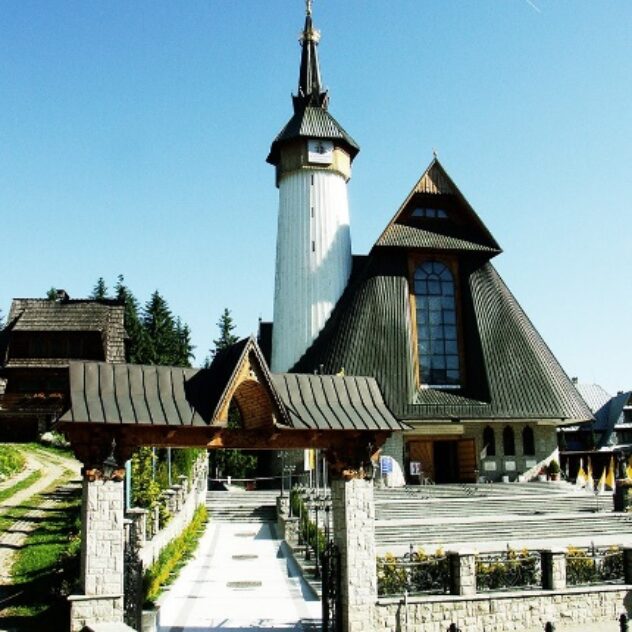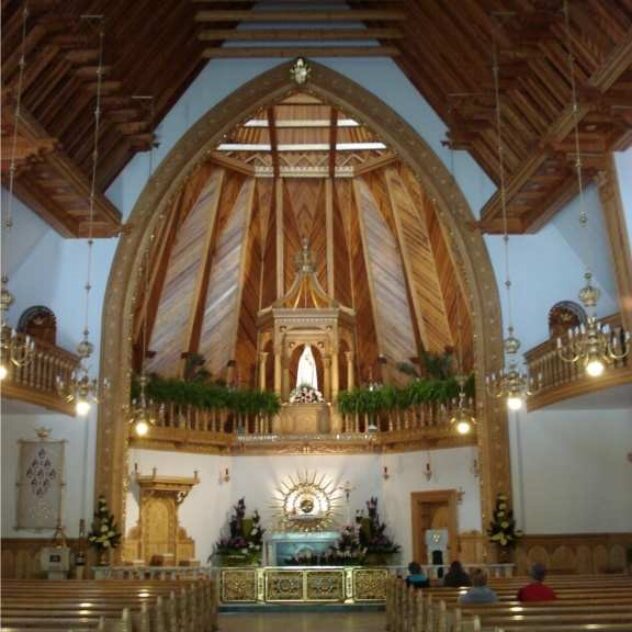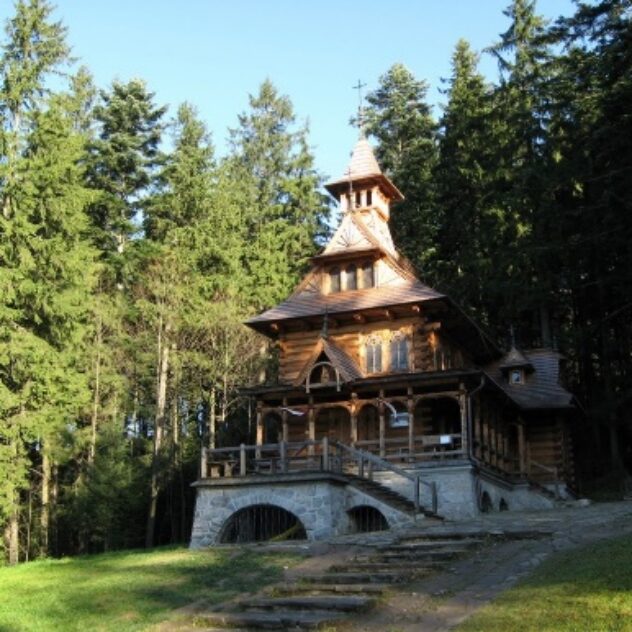The National Shrine of Our Lady of Fatima Zakopane - Krzeptówki
Information about the pilgrimage site
The Sanctuary of Our Lady of Fatima is situated about 2.5 km south-west of Zakopane, on Krzeptówki Street. It is the most important centre of devotion to Our Lady of Fatima and one of the oldest (after Tura Śląska) Fatima sanctuaries in Poland. According to data, more than one million people from more than 50 countries of the world make pilgrimages to this place.
The pastoral care of the Shrine is exercised by the Pallottine Fathers, who since 1946 have been propagators and missionaries of the cult of Our Lady of Fatima in Poland. The first Pallottine priests arrived in Zakopane in August 1950 in search of a place for a retreat house for seminarians and Pallottine missionaries. The place chosen, on the outskirts of Zakopane, was very poor at that time. Only a few old, historic houses stood there at the time. In 1951, a house and chapel dedicated to the Immaculate Heart of Mary were built in Krzeptówki, which was consecrated on 11 October 1959 by Archbishop Eugeniusz Baziak. Initially, the chapel housed a painting depicting the Fatima apparition of Our Lady to three shepherd children – Jacinta and Francisco Marto and Lucia do Santos.
The main building in the sanctuary complex in Krzeptówki is the Church of Our Lady of Fatima. The temple is a votive offering of thanks for saving the life of the Holy Father John Paul II on 13 May 1981. On that dramatic day in the history of the Church, after the Marian Appeal, the then parish priest Fr Miroslaw Drozdek declared: “If Our Lady of Fatima saves the life of the Holy Father, we will build a church here, which will be our thanksgiving and a symbol of Our Lady of Fatima’s victory”. The construction of the church began in 1987. On 13 May 1990, the Metropolitan of Krakow, Cardinal Franciszek Macharski, laid the cornerstone of the church – a partial stone from the tomb of St. Peter in Rome and a stone from the site of the first apparition of Our Lady at Fatima. A rosary given by John Paul II and a photograph of the Polish Pope were also embedded in the foundations of the church. The church in Krzeptówki was designed by Ing. arch. Stanisław Tylka from Zakopane, while the interior of the church was built according to the concept of the then custodian of the sanctuary, Father Mirosław Drozdek. The church was consecrated by Cardinal Franciszek Macharski on 13 May 1992.
The most important event in the history of the Shrine of Fatima Lady at Krzeptówki was the visit of John Paul II on 7 June 1997. The Holy Father celebrated Holy Mass at the shrine and consecrated the church. In his homily, the Pope emphasised the importance of this shrine to him with the words: “Dear brothers and sisters! Your shrine at Krzeptówki is particularly near and dear to me. There you venerate Our Lady of Fatima in her statue. The history of this Shrine is also connected with an event that took place in St Peter’s Square on 13 May 1981. At that time, I experienced a mortal threat to life and suffering and, at the same time, the great mercy of God. Through the intercession of Our Lady of Fatima, my life was given back to me”.
The chancel of the church refers to the papal tiara, while the tabernacle is depicted in the form of a monstrance. Above the tabernacle is a statue of Our Lady, who ‘watches over’ the Blessed Sacrament. Also noteworthy in the sanctuary is the papal throne from which Holy Father John Paul II presided over the liturgy of the consecration of the sanctuary, as well as stained-glass windows depicting the history of Our Lady’s apparitions in Fatima in 1917 and the relationship of the Fatima sanctuary and the sanctuary in Krzeptówki with St. John Paul II. The Sanctuary of Our Lady of Fatima in Krzeptówki in Zakopane is currently the most important centre of devotion to Our Lady of Fatima in Poland.
The importance of this centre can be evidenced by the fact that it was chosen by the Polish Bishops’ Conference as the place for the renewal of the Act of Consecration of Poland to the Immaculate Heart of Mary. This celebration took place on 6 June 2017, i.e. on the 100th anniversary of the apparitions of Our Lady of Fatima, and was attended by the President of Poland Andrzej Duda, Prime Minister of the Polish Government Beata Szydło, Archbishop Stanisław Gądecki – President of the Polish Bishops’ Conference, cardinals, bishops, clergy and faithful from many corners of Poland. The Fatima Solemnities and the Fatima Vigils, commemorating the apparitions of Our Lady at Fatima, as well as the devotions celebrated on the first Saturdays of the month, have the most important place in the pastoral programme of the Shrine. Each of these prayer meetings is attended by several hundred to several thousand faithful.
By a resolution of the Polish Bishops’ Conference of 14 March 2018, the Zakopane sanctuary in Krzeptówki was established as the National Sanctuary of Our Lady of Fatima. On 28 March 2018, at the KEP Secretariat in Warsaw, the resolution on this matter was handed over by the President of the Polish Bishops’ Conference, Archbishop Stanisław Gądecki, to the custodian of the sanctuary, Fr Marian Mucha, and the Provincial Superior of the Pallottine Fathers, Fr Zenon Hanas.
Tourist attractions in the vicinity
Papal altar in the park – in the park at the back of the Sanctuary there is an altar at which the Holy Father John Paul II celebrated Mass on the eve of his visit to the Sanctuary. It is meant to remind us of the magnificent liturgy under the Great Rafter and of the Pope’s words said during it: “Christ is the fulfilment of God’s plan of redemptive love. In virtue of this plan, man has access to God, not only as a creature to his Creator, but as a child to the Father. Christianity means a new creation, a new life – life in Christ, through whom man can say to the Father: Abba – my Father, our Father”. The entire park is a place dedicated to prayer and reflection on the Marian path that the Holy Father walks every day. Pilgrims walking down the path towards the papal altar encounter Marian signs of John Paul II’s spirituality along the way: his beloved statues and Marian images. The small chapels include Our Lady of Ludźmierz, of Kalwaria Zebrzydowska, of Wadowice, and the Pope’s beloved Our Lady of Guadalupe – the destination of his first papal pilgrimage in January 1979. Web: https://smbf.pl/sanktuarium-narodowe/swiete-miejsca-w-sanktuarium/ .
Church of the Holy Family – is located on a small hill. Surrounded by a metal fence with stone pillars containing 14 chapels – Stations of the Cross and the Grotto of Our Lady of Lourdes. The church is built of stone (sandstone and limestone) oriented on the east-west axis, three-naved, with a narrower presbytery closed with a semicircle, with a quadrilateral tower at the front, with round communication towers reaching the height of the roof. The side aisles are flanked by symmetrical trilateral chapels of Our Lady of the Rosary (No. 1) to the north and Sacred Heart of Jesus to the south. On either side of the presbytery, also symmetrically, are adjoining rectangular annexes – the chapel of St John the Baptist to the north, the sacristy to the south. The nave and chancel have cross vaults. The walls of the nave are covered with a polychrome on the theme of the ‘eight beatitudes’ in a Highlander interpretation. Made in bright colours, it depicts, among others, the figures of: St Francis, Count Władysław Zamoyski, St Brother Albert, Father Józef Stolarczyk. The roof over the nave and presbytery is single-pitched, gabled, and pulpit over the side aisles. The church is in Neo-Gothic style with narrow windows in Neo-Romanesque style with stained-glass windows designed by Stanisław Witkiewicz, protected from the outside by grilles depicting the 15 mysteries of the Rosary. The author of the architectural design of the church was Jozef Pius Dziekoński year 1876. The construction of the church began on 12 August 1877 by Fr. Jozef Stolarczyk, the first parish priest of Zakopane. The church was completed in 1896. under the second parish priest, Rev. Kazimierz Kaszelewski (he also erected the cross on Giewont with the highlanders on 19.08.1901r), and consecrated on 16 September 1899 by the Bishop of Cracow, Rev. Jan Puzyna. Web: https://swrodzina.net/sanktuarium/ .
Cmentarz na Pęksowym Brzyzku – this historic necropolis, located near the lower Krupówki, is undoubtedly one of the most important sights in Zakopane. The atmospheric Old Cemetery in Pęksowy Brzyzku is the spiritual centre of the city and, next to Warsaw’s Powązki Cemetery , is one of the most important Polish cemeteries. It is here that people without whom Zakopane would be just a poor village lost at the foot of the Tatra Mountains have their graves.
The gate leading to the cemetery bears a plaque that reads: “Homeland is land and graves. Nations losing memory lose life”. On the other is a notice that the cemetery is a historic site. Also visible here is a list of people who are Tatra Couriers.
Initially an ordinary village cemetery where the inhabitants of Zakopane were buried, it became a special place in 1889, when Dr. Tytus Chałubiński was laid to rest there in accordance with his wishes. At present, there are about 250 graves in Pęksowy Brzyzek. A large part of them are tombs of people who love the Tatra Mountains and Zakopane and who have made a contribution to the region, and some are tombs of highlander families. In fact, each of the tombs is a unique work of art, made of stone, wood or metal. Here you will see tombs carelessly arranged as if in a village cemetery.
In a small area, there are graves of eminent people without whom Zakopane would not exist in its present form, including Jan Krzeptowski Sabała, Dr. Tyrus Chałubiński, Kornel Makuszyński, Kazimierz Przerwa Tetmajer, Rev. Józef Stolarczyk, Stanisław Witkiewicz, Stanisław Marusarz. Highland guides and couriers of the Tatra Mountains, mountaineers, poets and writers, doctors and artists and many others are buried here.
Willa pod Jedlami – in Koziniec, there is the most beautiful specimen of the Zakopane style designed by Stanisław Witkiewicz and one of the greatest monuments of wooden architecture in Poland. The House under the Jedlami is the property of the Pawlikowski family, highly meritorious for the Polish culture of art, the protection of the nature of the Tatra Mountains and Zakopane. The house was built in 1897 by Jan Gwalbert Pawlikowski from Medyka in a short period of time, only 9 months, by builders from Zakopane led by Wojciech Roj (Raj).
The building can only be viewed from the outside; it looks particularly impressive from Antałówka. The house, on a 4-metre high foundation with an open veranda facing the Tatra Mountains, impresses with its proportions and its shape – it is undoubtedly a peak achievement of the Zakopane style. In the garden surrounding the house is a wooden well, also designed by Stanisław Witkiewicz, similar in shape to a chapel or a church bell tower. The interior of the villa was also designed by Witkiewicz – from the doorknobs to the cookers, all bear features of Highlander ornamentation. Some of the furniture inside the house was made by Wojciech Brzega, a well-known Zakopane sculptor.
Willa Koliba – the first house in the Zakopane style, built in 1892 for the Ukrainian landowner Zygmunt Gnatowski. The building was constructed by highlanders Jozef Kspruś-Stoch and Maciej Gąsienice-Józkowy. Initially small, the west wing was added in 1903, which completely changed its proportions. The house now houses the Stanisław Witkiewicz Museum of Zakopane Style, a branch of the Tatra Museum. Inside, many things designed by Stanisław Witkiewicz are gathered, as well as ethnographic exhibits. The pavilions were made by the excellent Zakopane artist-sculptor Wojciech Brzega.
The author of the statue of Jan Krzeptowski-Sabała, which can be seen outside in the porch, is the excellent Zakopane artist Michał Gąsienica-Szostak. In the past, Koliba was frequented by many distinguished guests, including: Helena Modrzejewska, Jan Kasprowicz. In recent years, Koliba has been extensively renovated and in places reconstructed.
The Chapel in Jaszczurówka – designed by Stanisław Witkiewicz and built in the Zakopane style – is considered one of the flagship works of this style. The Chapel of the Sacred Heart of Jesus was founded in 1903 by the sons of Adam Uznański, after his death. Construction began in 1904 and was consecrated in 1907. This one of the smallest churches in Zakopane was built from spruce wood without the use of a nail. The body of the chapel with a high foundation is wonderfully integrated into its surroundings, the whole is covered by a gable roof covered with shingles, dominated by a characteristic turret with a little bell. Above the entrance, under a small roof, is a wooden statue of the Sorrowful Christ, the work of Josef Janos of Dębno. Noteworthy in the church is the entrance door and the sacristy door, richly decorated with wood carving techniques and pegging and hardware.
The interior of the chapel also impresses visitors with its highland artistry. Attention is drawn to the decorations, the mastery of the sculptures and ornamentation. The extremely interesting and original main altar resembles a highland cottage, with beautiful stained-glass windows on the sides: on the left – Our Lady of Ostra Brama with the Coat of Arms of Lithuania; on the right – Our Lady of Czestochowa with a crowned eagle. The altar and stained glass windows were designed by Stanislaw Witkiewicz. Note the massive oak candelabra hanging in the chapel.
You can find out about Zakopane’s other tourist attractions here:
https://www.zakopane.pl/strefa-turystyczna/turystyka/atrakcje-turystyczne
Accommodation
- Accommodation for pilgrims:
https://www.zakopane.domswelzbiety.pl/
https://www.zakopane.faustyna.pl/wypoczynek-w-zakopanem-na-krzeptowkach/
- Nearby other private accommodation
Availability
By car
The Sanctuary can be reached by car. There are car parks in the area, which are usually chargeable. The distance from the car park to the Sanctuary itself is approximately 500 metres.
By public transport
Zakopane can also be reached by bus or train. From there you can then take a city bus or a private bus to the area around the Sanctuary. From the bus stop you have to walk about 500 metres to your destination. From the railway or bus station, the Sanctuary can also be reached on foot. The distance is approx. 4 km.
On foot
For those who prefer walking, there are several hiking trails leading to the area around the Sanctuary, the most popular of which is the trail from Zakopane via Droga pod Reglami.
On a bicycle
There are also several cycling routes around Zakopane that lead towards Krzeptówki. However, please note that some parts of the routes can be demanding for less experienced cyclists.








